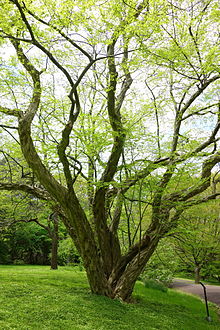Pteroceltis
| Pteroceltis Temporal range:
| |
|---|---|

| |
| Pteroceltis tatarinowii at the Morris Arboretum | |
| Scientific classification | |
| Kingdom: | Plantae |
| Clade: | Tracheophytes |
| Clade: | Angiosperms |
| Clade: | Eudicots |
| Clade: | Rosids |
| Order: | Rosales |
| Family: | Cannabaceae |
| Genus: | Pteroceltis Maxim. |
| Species[citation needed] | |
| |
Pteroceltis is a genus of small trees in the family Cannabaceae and containing the living species Pteroceltis tatarinowii.[1] The genus is now restricted to an endemic range in China and Mongolia. The genus has a fossil record which includes species described from Korea, Japan, Germany, and the United States.[2]
The fossil record includes one described species from North America, † from the Middle Eocene Cockfield Formation in Tennessee, while an undescribed species is known from the Klondike Mountain Formation of Washington. One late Oligocene species † has been described from strata near Rott, Germany. The largest diversity of fossils are from Asia, with † from the Miocene in China, the of Japan preserved †, and both † plus † known from the Miocene in North Korea.[2][3]
References[]
- ^ Zhang, Y.; Wang, G.; Zhou, J.; Zhou, X.; Li, P.; Wang, Z. (2019). "The first complete chloroplast genome sequence of Pteroceltis tatarinowii (Ulmaceae), an endangered tertiary relict tree endemic to China". Mitochondrial DNA Part B. 4: 487–488. doi:10.1080/23802359.2018.1544861.
- ^ a b Manchester, S. R.; Chen, Z.D.; Lu, A. M.; Uemura, K. (2009). "Eastern Asian endemic seed plant genera and their paleogeographic history throughout the Northern Hemisphere". Journal of Systematics and Evolution. 47 (1): 1–42.
- ^ Wong, W.; Dilcher, D.; Uemura, K. (2019). "Three new fossil-species of Pteroceltis (Cannabaceae) from East Asia". Phytotaxa. 409 (1): 1–11.
- Cannabaceae
- Plants described in 1873
- Trees of China
- Endemic flora of China
- Rosales genera